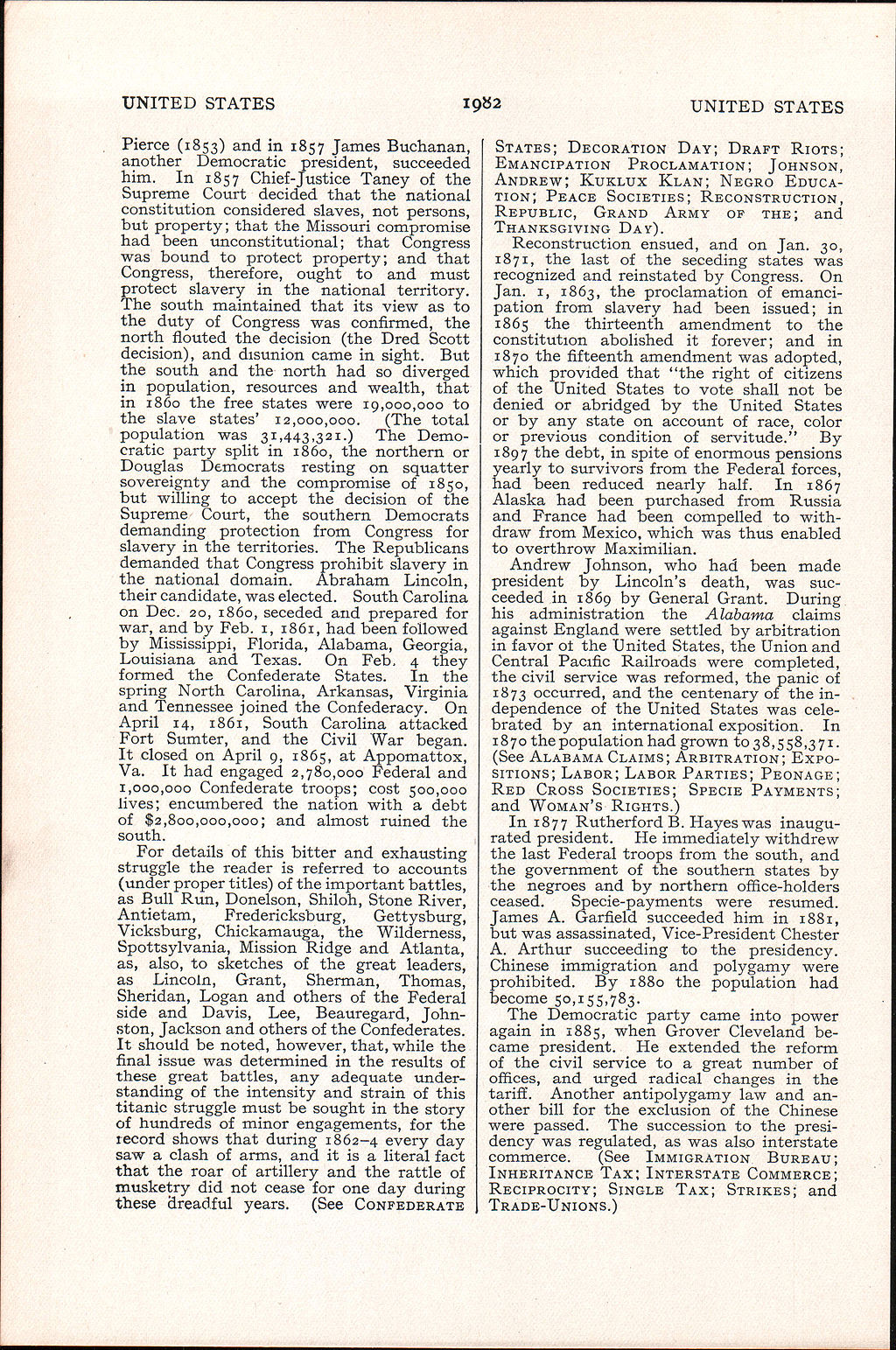Pierce (1853) and in 1857 James Buchanan, another Democratic president, succeeded him. In 1857 Chief-Justice Taney of the Supreme Court decided that the national constitution considered slaves, not persons, but property; that the Missouri compromise had been unconstitutional; that Congress was bound to protect property; and that Congress, therefore, ought to and must protect slavery in the national territory. The south maintained that its view as to the duty of Congress was confirmed, the north flouted the decision (the Dred Scott decision), and disunion came in sight. But the south and the north had so diverged in population, resources and wealth, that in 1860 the free states were 19,000,000 to the slave states' 12,000,000. (The total population was 31,443,321.) The Democratic party split in 1860, the northern or Douglas Democrats resting on squatter sovereignty and the compromise of 1850, but willing to accept the decision of the Supreme Court, the southern Democrats demanding protection from Congress for slavery in the territories. The Republicans demanded that Congress prohibit slavery in the national domain. Abraham Lincoln, their candidate, was elected. South Carolina on Dec. 20, 1860, seceded and prepared for war, and by Feb. 1, 1861, had been followed by Mississippi, Florida, Alabama, Georgia, Louisiana and Texas. On Feb, 4 they formed the Confederate States. In the spring North Carolina, Arkansas, Virginia and Tennessee joined the Confederacy. On April 14, 1861, South Carolina attacked Fort Sumter, and the Civil War began. It closed on April 9, 1865, at Appomattox, Va. It had engaged 2,780,000 Federal and 1,000,000 Confederate troops; cost 500,000 lives; encumbered the nation with a debt of $2,800,000,000; and almost ruined the south.
For details of this bitter and exhausting struggle the reader is referred to accounts (under proper titles) of the important battles, as Bull Run, Donelson, Shiloh, Stone River, Antietam, Fredericksburg, Gettysburg, Vicksburg, Chickamauga, the Wilderness, Spottsylvania, Mission Ridge and Atlanta, as, also, to sketches of the great leaders, as Lincoln, Grant, Sherman, Thomas, Sheridan, Logan and others of the Federal side and Davis, Lee, Beauregard, Johnston, Jackson and others of the Confederates. It should be noted, however, that, while the final issue was determined in the results of these great battles, any adequate understanding of the intensity and strain of this titanic struggle must be sought in the story of hundreds of minor engagements, for the record shows that during 1862-4 every day saw a clash of arms, and it is a literal fact that the roar of artillery and the rattle of musketry did not cease for one day during these dreadful years. (See
Confederate States;
Decoration Day; Draft Riots; Emancipation Proclamation; Johnson, Andrew; Kuklux Klan; Negro Education; Peace Societies; Reconstruction,; Republic, Grand Army of the; and Thanksgiving Day).
Reconstruction ensued, and on Jan. 30, 1871, the last of the seceding states was recognized and reinstated by Congress. On Jan. 1, 1863, the proclamation of emancipation from slavery had been issued; in 1865 the thirteenth amendment to the constitution abolished it forever; and in 1870 the fifteenth amendment was adopted, which provided that “the right of citizens of the United States to vote shall not be denied or abridged by the United States or by any state on account of race, color or previous condition of servitude.” By 1897 the debt, in spite of enormous pensions yearly to survivors from the Federal forces, had been reduced nearly half. In 1867 Alaska had been purchased from Russia and France had been compelled to withdraw from Mexico, which was thus enabled to overthrow Maximilian.
Andrew Johnson, who had been made president by Lincoln's death, was succeeded in 1869 by General Grant. During his administration the Alabama claims against England were settled by arbitration in favor of the United States, the Union and Central Pacific Railroads were completed, the civil service was reformed, the panic of 1873 occurred, and the centenary of the independence of the United States was celebrated by an international exposition. In 1870 the population had grown to 38,558,3 71. (See Alabama Claims; Arbitration; Expositions; Labor; Labor Parties; Peonage; Red Cross Societies; Specie Payments; and Woman's Rights.)
In 1877 Rutherford B. Hayes was inaugurated president. He immediately withdrew the last Federal troops from the south, and the government of the southern states by the negroes and by northern office-holders ceased. Specie-payments were resumed. James A. Garfield succeeded him in 1881, but was assassinated, Vice-President Chester A. Arthur succeeding to the presidency. Chinese immigration and polygamy were prohibited. By 1880 the population had become 50,155,783.
The Democratic party came into power again in 1885, when Grover Cleveland became president. He extended the reform of the civil service to a great number of offices, and urged radical changes in the tariff. Another antipolygamy law and another bill for the exclusion of the Chinese were passed. The succession to the presidency was regulated, as was also interstate commerce. (See Immigration Bureau; Inheritance Tax; Interstate Commerce; Reciprocity; Single Tax; Strikes; and Trade-Unions.)
